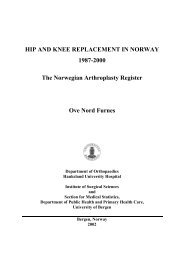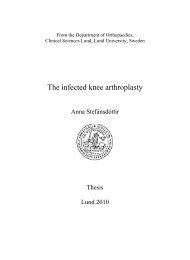E-Book German Arthroplasty Register EPRD - EAR - EFORT
E-Book German Arthroplasty Register EPRD - EAR - EFORT
E-Book German Arthroplasty Register EPRD - EAR - EFORT
You also want an ePaper? Increase the reach of your titles
YUMPU automatically turns print PDFs into web optimized ePapers that Google loves.
The data collected are analysed according<br />
to a previously agreed evaluation concept<br />
involving experts from the Orthopaedic<br />
Society and all other <strong>Register</strong> partners, the<br />
central outcome being prosthesis survival.<br />
The times of prosthesis implantation and<br />
revision surgery are determined from the<br />
health insurance provider’s routine data.<br />
The participating health insurance funds<br />
regularly forward the datasets referring to<br />
prosthesis implantations to the <strong>Register</strong><br />
point at the BQS Institute for the calculation<br />
of implant survival times. Allocation of later<br />
re-operations and hence linking of primary<br />
and revision interventions is made possible<br />
through pseudonymisation in compliance<br />
with the requirements of <strong>German</strong> Data Protection<br />
legislation. To determine the survival<br />
time, parts of the routine datasets, implant<br />
codes as well as other relevant parameters<br />
(e.g. co-morbidities) are linked longitudinally<br />
at the <strong>Register</strong>. The vital status of patients,<br />
which is important for calculating implant<br />
survival, can be verified from health insurance<br />
fund data.<br />
Implant survival times are comparatively<br />
analysed using the Kaplan-Meier estimator<br />
as well as the Cox regression model.<br />
Among other things, these methods serve to<br />
estimate the probability of a patient requiring<br />
revision surgery within a certain time<br />
interval. The Cumulative Revision Rate (CRR)<br />
indicates the percentage of patients who are<br />
expected to undergo revision surgery as a<br />
function of time.<br />
The data are carefully adjusted involving the<br />
scientific and practical expertise of the specialty<br />
societies. Risk adjustment is performed<br />
The <strong>German</strong><br />
<strong>Arthroplasty</strong> <strong>Register</strong><br />
(<strong>EPRD</strong>)<br />
based on essential influencing<br />
factors, such as age, gender,<br />
5. Evaluation<br />
weight or principal diagnosis.<br />
Furthermore, the type of<br />
prosthesis (e.g. unicondylar vs. bicondylar), bone cement,<br />
retropatellar replacement and implant model, as well as<br />
the hospital, department or institution performing surgery<br />
are evaluated in due consideration of the incidence<br />
and prevalence of arthroplasty treatment.<br />
By sophisticated analysis of implants and implant components<br />
with high failure rates, for example, treatment<br />
problems and deficits in outcome can be identified.<br />
Thus, an assessment is taking place of the treatment and<br />
outcome quality, patient safety, and efficiency of the<br />
medical device “endoprosthesis“.<br />
Structure, Procedures and Organisation<br />
13









